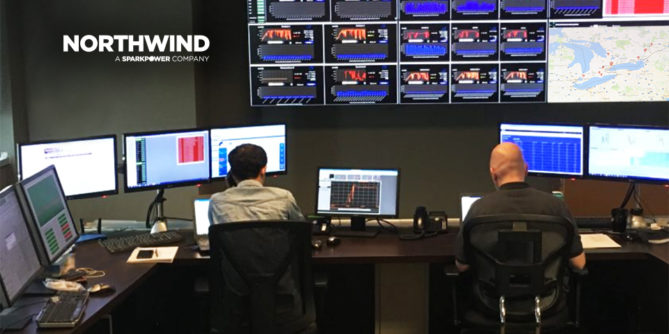Let’s imagine you operate a manufacturing facility producing 500 widgets an hour. Now imagine your facility experiences a power outage for two hours; you would be down 1000 widgets. What could you do to resolve the shortage? One option might be to hire additional labour resources. Another would be to extend your working hours to compensate. What if instead of widgets, your manufacturing facility produces energy through solar or wind assets? How can you make up for downtime and maximize your renewable assets when you’re unable to hire more wind or extend daylight hours past dusk?
Uptime Upkeep
For renewable projects, in particular, financial viability is dependent on maximizing the uptime of your assets and thus requires that projects are constantly monitored and you have the right team in place to troubleshoot and remedy issues effectively. To date, this has largely been accomplished remotely using a variety of SCADA or customized computer applications or systems. As wind and solar projects and investments become more common, the flaws inherent in traditional O&M monitoring approaches are becoming more apparent.
Each project has a large EPC firm (engineering, procurement, and construction) designing and building out the asset in its entirety. These firms will hire a company which purchases and implements their own SCADA system (Supervisory Control And Data Acquisition) with their own design and configuration resulting in many asset/property owners having to manage several different SCADA platforms with varying capabilities. This often requires dedicated staff to actively monitor multiple and varying projects. Additionally, in many cases, the networking capabilities and alarming technologies built into those SCADA systems provide limited mechanisms to deliver real-time alarms, meaning downtime is reported more slowly – if at all. It is rare for this initial SCADA implementation to go beyond a minimum requirement for basic operational capabilities allowing for data to be pulled but requiring manual analysis. Online performance analytics capabilities are often not germane to these SCADA products or at the very least, are not configured at the time of a project’s go-live.
The bottom line? Though the equipment may be generating an impressive amount of performance and fault data, in many cases the owner isn’t privy to the information. Wind and solar farms can generate data every 10 seconds or faster, but where is the data going? GE has estimated a mere 2% of the data generated in the energy industry is actually used[1].
The Cost of Downtime
On the longest days of the year, a solar project should receive upwards to 13 hours of generation. For a 10MW solar farm on a clear sunny day in the summer, this could amount to $35,000 in potential revenue.[2]
Owners are paid based on a kWh agreement with the local hydro utility. An hour of downtime (which in many cases can become 2, 3, 4, or 5 by the time an interruption is reported, and repair technicians are mobilized and arrive on site) is an hour of lost revenue that can’t ever be replaced, making the reduction of downtime critical to the long-term success of renewable assets.
Implementing Solutions
The World Economic Forum predicts digitizing electricity generation, distribution, and consumption could create $1.3 trillion within 10 years. Of that, roughly 1 in every 3 dollars- or $387 billion- would be attributed to eliminating unplanned downtime!
At Spark Power, we believe the key to maximizing the profitability of renewable assets lies in efficiently monitoring and analyzing performance, responding to issues quickly, and using technology safely to provide a wide-lens view of an entire operation.
Our Renewable Power Services division, Northwind, has been achieving significant success through consolidating and normalizing disparate SCADA systems to create a centralized view of an entire asset pool. This is accomplished by layering a cross-platform, operating system agnostic solution overtop the disparate SCADA systems on any given property. Our team of professionals has unique skills in providing real-time monitoring and is equipped to immediately mobilize technicians the moment an interruption is detected, instantly reducing downtime.
Additionally, our full-spectrum performance analytics enable us to keep our clients informed about how their solar or wind asset is performing and produces contemporary reporting useful to our clients for all their internal and external needs. Northwind also offers its customers a live portal providing transparent information sharing about the health of their investments. This is a unique offering in an industry which is known to struggle with sharing information about asset performance.
Maximize Renewable Assets Today
The vast pool of data we analyze allows us to operate within a completely unique business model; Northwind is proud to offer performance-based contracts that smooth out all the variables and establish a single price with opportunity for additional incentives in the future. It’s a comprehensive solution that provides immediate results.
Spark Power delivers a broad range of customized services to ensure maximum efficiency, reliability, and safety of renewable assets. We have a broad range of deep technical experience from years of managing wind and solar assets in a variety of settings and climates.
Contact our team today to learn more about how Spark Power and Northwind can assist you in getting the most out of your solar and wind operations.
Footnotes
[1] IoT Agenda, “Industrial IoT: Creating Value, Transforming Business Models”, http://internetofthingsagenda.techtarget.com/blog/IoT-Agenda/Industrial-IoT-Creating-value-transforming-business-models
[2] Actual dollar value based on market structures such as feed in tariff pricing. This example assumes an Ontario FIT 1 solar farm.
